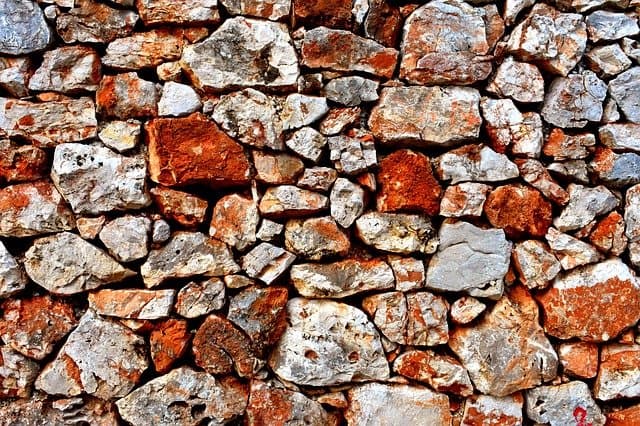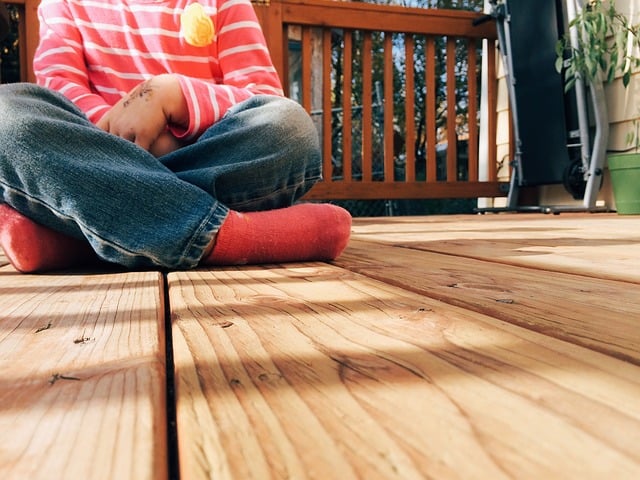How To Paint a Deck with Peeling Paint
Perhaps your deck is covered with old peeling paint and wonders how to clean and repaint. Frequent peeling paint on your deck surfaces makes them get defaced/breached, thus losing its aesthetic appearance. 
So, on how to paint a deck with peeling paint – prepare personal protective equipment, and sort the right painting tools.
Then, prepare the deck surface, select the right paint, sand/polish the deck entirely, and finally carry out the actual painting. Your paint deck for the outdoor deck must be quality and durable.
See Also: Stain a Deck for the First Time
Details: How To Paint a Deck with Peeling Paint Fast
a. Use Personal Protection equipment
Before starting the painting process, you need to have the following protection equipment:
- Eye goggles and hand gloves
- Safety boots/footwear and helmet – where needed
- Overall/dust coat – heavy duty
- Ear protector and reflector – for a busy environment
- Face mask
NB: Put on the protective gear before you begin any task.
b. Paint Tools Selection and Preparation
It will help if you check on the number of painted layers, nature of the surface, and weather conditions before paint application – with high-quality paint. Notably, keenly follow precautions and instructions given by paint manufacture before painting.
- Paintbrush or a roller
- Paint sprayer – for a small or large task
- Scraper and sandpaper
- Grinder- thick paint layer
- Blower – cleans dust
- Power source – where necessary
See Also: Can You Use Acrylic Paint On Metal?
c. Paint Selection and Preparation
Paint selection entails proper considerations of the type of paint that match the deck surface texture and color.
Whether you want to use latex paint or acrylic paint, the intended stay-period before repainting should always click in your mind first as this determines the number of layers to apply and paint type to purchase.
Some deck surfaces may require a primer or prepping to improve stickiness strength, while others can be painted directly. Moreover, most latex paints need a primer before the actual application to improve surface contact and protect primary material.
Usually, when selecting paint for your deck surface, consider factors such as:
- Cure time
- Cost of the paint
- Availability in the market
- Ease to remove
- Durability
- Colors available
Paint preparation requires strict adherence to the manufacturer’s instruction. Latex paint needs little or no dilution, while acrylic paint requires thinning to achieve the best paint concentration before application.
Besides, you should carry out a drop test before the actual painting to ascertain the performance of a given paint concentration on a deck surface. Otherwise, you may end up wasting paint by over-dilution or high solvent concentration, which may not stick nicely on the surface.
NB: Always stick to one particular type of paint for the next deck restoration to improve your deck service life and attain unmatched surface finish – frequent change of paint affects the primary material and deck microstructure with time.
d. Surface Preparation
Wrong surface preparation is one of the main reasons why paint peels. In this regard, you will need to follow the following steps:
- Surface cleaning. You will need to wipe the deck surface with a paintbrush or cloth to remove the dust layer in this process. You may sometimes opt to spray water (best for acrylic painted surfaced) on the surface to quicken the dust removal process. However, this method is not the best for latex paint since it affects prepping or stripping action.
- Paint striper application. Apply paint stripper to soften thick paint layer bonds for easier scraping. Paint stripers may increase overall cost but help quicken the work at the end.
- Scrapping Process. Gently, scrap off the cured painted surface to remove old paint and surface debris. Use a paintbrush to wipe off dislodged paint peels and collect them nicely in a dustbin. Scrapping is meant to clean off the paint layer and leave a naked primary surface.
- Deck Filling and Sanding. Fill holes and cavities with high-quality putty or body filler or sealer to eliminated ruggedness. Now sand the peeling areas. Prime the surface before sanding the filled section.
- Use sandpaper when sanding your deck to remove old paint traces and attain a clean primary surface.
Polishing. Polish the surface with fine-grit sandpaper to eliminate any roughness that may be created during the sanding process. Also, polishing improves the stickiness ability of the paint on the deck surface. Remember to clean off dust after polishing – it affects paint stickiness during application.
See Also: Top Deck Stain for Pressure Treated Wood
e. Final Paint Application
When carrying out the final paint application process, consider the procedure given below:
- Dip the paintbrush or roller in the paint and soak it sufficiently. But a portable paint sprayer will make the painting task easier and faster.
- Apply gently over the deck surface to and fro – start with vertical painting motion and finish with the horizontal application. Paint sprayer works best to deliver the best surface finish
- Let the first coat dry before applying another paint layer – the drying time may vary according to the manufacturer’s recommendation. However, 2 to 4 hour time is suitable for latex paint
- Blow air over the painted surface to accelerate the quenching process – you can leave it to cure naturally
- Sprinkle water over the deck (for acrylic paint) to remove and keep off dirt particles that make stick due to electrostatic attraction
- Leave the painted surface to cure – some people also consider swing stain staining as an alternative.
It may take 1 to 7 days for the painted surface to achieve strong surface coating. Do not sand the painted surface (distorts the fine surface finish or affect the primary surface material).
Notably: The best paint selection always leads to a perfect and durable coat finish when proper painting procedures are followed.
What Makes Paint to Peel?
It is never guaranteed that your newly painted deck would maintain the current state forever. Peeling action is one of the significant challenges that affect painted surfaces. If you have faced such a problem, the following are possible reasons why peeling occurs on the deck surface.
1. Paint quality
Low-quality paint peels faster due to the inability to maintain original stickiness with time. You can tell the best quality paint through a drop test over a given surface – high-quality paint sticks faster and cures in a shorter time. Low-quality paint is difficult to apply and takes a longer time to dry/stick.
Consider close observation on surfaces painted using those particular types during paint selection and get more testimonies from previous buyers before placing your order. In case it’s new paint in the current market, let the manufacturer bear the quality guarantee.
See Also: Chemical Paint Remover for Wood
2. Moisture content
Moisture content kills the paint stickiness by weakening the paint molecular bonds in contact with the primary surface. Usually, the deck’s base structure gets weaker due to wetness and detaches the paint chemical formulation, thus breaking the paint-deck surface bond.
Latex paint is mostly affected by moisture as compared to acrylic paints. Consider painting your deck with acrylic paint to reduce peeling action and improve its surface life for a humid environment.
3. Presence of dirt
Dirt/dust weakens paint surface bonds and accelerates breaching or defacing off paint color. Moreover, debris settled on the surface destroys the uniform paint molecular bonds leading to chipping that eventually peels off.
You will need to dust or wash your deck often to remove dirt that may have settled on the surface with time. Remember, latex painted deck shouldn’t be washed; instead, you should blow air over the surface or wipe to remove dust/dirt.
4. Poor Surface Preparation
Incomplete removal of debris or polished dust during the surface preparation process accelerates peeling due to surface bond weakness.
Fine dust is dangerous to paint chemical formula as they settle within the intermolecular spaces weakening the overall stickiness ability. Ensure the deck surface is spotlessly clean before paint application.
5. Application method
The method selected when painting your deck matters a lot in that the paint quality finish may fail to be achieved, leading to quick peeling off after a short period.
Spray painting gives the strongest surface paint layer, while the paintbrush offers a weak option. A roller is a better painting alternative as it maintains a more refined paint finish without drains as compared to a paintbrush.
NB: Application method is the least cause of paint peeling. It would help if you always focus on other factors listed above.
See Also: Removing Acrylic Paint from Canvas
Best Deck Paint
1. #1 Deck Wood Deck Paint and Sealer
Deck wood is a water-based wood paint and sealer that features a strong chemical formulation, which acts instantly upon application.
The solvent integrates advanced solid color sticks firmly on both horizontal and vertical wooden deck without dripping.
Besides, Deck Wood is more comfortable to apply and fast-drying. It resists fading, mildew, and peeling. More importantly, Deck wood hides wood grains completely.
See Also: Deck Stain for Weathered Wood
2. KILZ Interior/Exterior Deck paint
Kilz is a reliable deck paint that features a simple water-based formulation, which has improved stickiness ability and low peeling action.
The acrylic latex paint is specially formulated with active natural ingredients that are self-activating. Indeed, the paint is self-priming and resistant to mildew. Notably, Kilz has low VOC and fast drying.
3. Rust-Oleum Corporation 260925
Rust-Oleum is a resilient waster-based prime sealer that features complex chemical formula, which sticks firmly on the deck without peeling off. The triple thick primer comes with outstanding flexibility and dries off faster.
Indeed, Rust-Oleum is more comfortable to apply and leaves a smooth finish surface that is resistant to peeling action. Essentially, Rust-Oleum can be used in both interiors or exterior work surfaces.
See Also: WD 40 Removes Paint?
Conclusion
When painting a deck with peeling paint, you will need to prepare personal protective equipment, prepare the surface, and sort the right painting tool. Then, select the right paint, sand/polish the deck entirely, and finally carry out the actual painting.
Besides, Proper procedure should be followed to boost service life before paint restoration/repainting. It is also necessary to consider paint type, method of application, surface texture, moisture level, and paint quality before you start painting as they are the root cause of paint peeling off.



